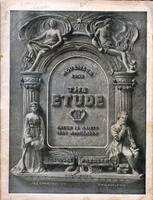The lack of technical training for girls was once more exemplified to me when I had the pleasure lately of calling on Miss Wedlake to see her beautiful work in organ building, writes Mrs. Greenwood, in The Queen. It is really sad, when one realizes the enormous number of female workers who overcrowd certain professions, to discover how close shut is the door to so many which are indisputably within the range of the physical strength and capabilities of the average woman. To a student of economics the more closely one examines the field of labor open to women the more one is struck with the difficulties which women have to overcome before they are able to attempt to compete in the market with men workers.
Miss Wedlake has happily had none of these difficulties. Her father being an eminent organ builder, and man of liberal ideas, far in advance of his generation, she has been able to learn all that was necessary for her to work in his factory.
In organ building (as in many other trades) a woman cannot be apprenticed, and therefore the few who are in the trade have depended on male relatives for their instruction in this delicate and beautiful art. Organ building unlike many other businesses, is an absolutely healthful trade, and therefore cannot be forbidden on that ground. Extreme delicacy of touch combined with unerring accuracy of eye is wanted in the putting together, leathering, and gusseting of the little bellows. The wood in separate blocks is delivered to Miss Wedlake, who then procedes to form the bellows by the accurate adjustment of pieces of white kid cut to the exact size required, and no mechanical aid is used in any of the manufacturing process. The ornamenting of organ pipes is also a branch of the work which comes within the scope of this industry for women workers.
The pipes arrive in their unfinished condition, and the worker then proceeds to devise a scheme of decoration, which is usually ecclesiastical in nature. Miss Wedlake has now the deftness and lightness of touch which long habit and devotion to her work has given her, and she is able not only to begin by making the pneumatic bellows, and to proceed to the decoration of the pipes, but to take the instrument, entirely in pieces, to any place where it is required, fix it up, tune it, and leave it ready for use.
The entire leathering of the main bellows of the organ at St. Jude’s, South Kensington, was done by her, the organ being built by her father for Dr. Forrest (the then vicar) when St. Jude’s stood in a field of cabbages.
Miss Wedlake works at decorating pipes for many firms. I was much interested in a wonderful piece of mechanism which she showed me, called an “Eclipse pneumatic,” which was invented and patented by her talented father, and won for him the highest award at the Inventions Exhibition of 1885. The work looked very beautiful, and was substantially from the hands of Miss Wedlake.
As I talked to her, George Meredith’s words about women came to my mind: “What nature originally decreed men are beginning to see, … and they are fitted for most of the avenues open to energy.”
Organ-pipe voicing, according to a great authority on the subject, is very suitable for women. It is on record that Miss Abbey, a member of an English organ-building family settled in France, was considered far superior to any French organ builder in her voicing of the diapasons and other pipes of that class. A delicate and sensitive musical ear, physique sufficiently strong to lift the less heavy pipes, some simple cheap tools, and about as much skill in their use as is required in very modest wood-carving, are the equipment necessary to start with in an organ builder’s factory. The most difficult and highly paid branch of this industry is reed voicing; not the reeds of harmoniums, but of real organs. This is tedious to learn, and takes years to master thoroughly.



